Music, film & wine: 12 days in California
It all started in September when I went on a musical journey to California to attend the Kaaboo Del Mar festival. This is an annually held festival that takes place in Del Mar, a beach city near San Diego, in southern California. Getting there was easy; from LA, I took the train to San Diego and got off at Solana Beach (the journey took about two hours) where I stayed for the duration of the festival. After the festival, I returned to Los Angeles, and after spending a few days there, I rented a car and went on a road trip to California. My itinerary included Santa Barbara, Big Sur, Carmel-by-the-Sea, the Yosemite National Park, Napa Valley, and, last but not least, San Francisco.
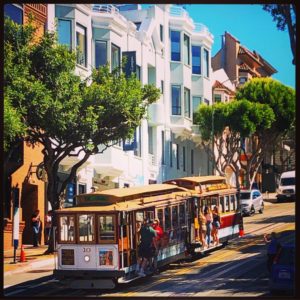
Here’s a 12-day itinerary I would recommend (slightly tweaked from the one I followed):
Day 1: DTLA (Downtown Los Angeles)
Start your day with breakfast and coffee. G&B is the most renowned coffee shop in Los Angeles. It is located in the Grand Central Market, a good place to get food too. Try their famous Almond Macadamia Iced Latte. Blue Bottle Coffee is another one of my favorite Californian coffeehouse chains. In Downtown LA, there are two cafes, one on Broadway opposite the Grand Central Market, and another one in the Arts District. The former is housed in the Bradbury Building, which is considered an architectural landmark.
Not far from there, on Spring Street, there’s the Last Bookstore. As the name suggests, this is a large bookshop selling both new and used books. On the second floor, there’s a book tunnel, especially popular with Instagrammers (myself included).
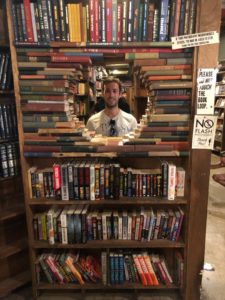
After the obligatory snaps there, continue to the Museum of Contemporary Art (MOCA) on Grand Avenue, which was founded 40 years ago. At present, it houses a rather limited number of galleries (the permanent collection features artworks by Joan Miro and Mark Rothko); however, the ticket is also valid at the second (and bigger) venue. Located in Little Tokyo, the Geffen Contemporary at MOCA is a 15-minute walk from the Grand Avenue location. Admission to both venues is free every Thursday from 5pm to 8pm. Both locations are closed on Tuesdays. Standard tickets cost $15. I would recommend going to the Grand Avenue location first, and then walking downhill to the Geffen Contemporary at MOCA.
As much as I enjoyed my visit to MOCA, I have mixed feelings about the Grammy Museum. It is located right next to the Staples Center, a multi-purpose arena which is the venue of the Grammy Awards ceremony and also the home venue to the Los Angeles Lakers. I enjoyed following the ‘Grammy Walk of Fame’ around the museum looking at the engraved pavement stones with some of the Grammy Award winners: best new artists, as well as songs, records and albums of the year, for each year since 1959. However, I found the actual museum rather underwhelming (tickets cost $15, closed on Tuesdays); I would recommend planning your visit to coincide with a special event. For example, Brett Young, Halsey and James Blake are among the artists who were recently there for a conversation followed by a performance.
Afterwards, continue to the Original Pantry Café, a diner that stays open 24/7. Located on Figueroa Street, the Pantry claims to never have closed since it opened in 1924. Try their burger with coleslaw, or pancakes for breakfast.
A visit to the Grammy Museum can also be combined with a mint mojito iced coffee (no alcohol in) from Philz, on the nearby Spring Street. Philz Coffee is another Californian coffeehouse chain that I really love.
In the evening, why not go somewhere to watch the sunset from? In Downtown LA, there are many rooftop bars, including the Upstairs Bar at ACE Hotel (on the 13th floor of the United Artists building), and Spire 73 at the InterContinental. For the latter, you will be required to pay $10 to get in, but then again it is on the top of the tallest building in Los Angeles. The Wilshire Grand Center, as the skyscraper is officially known, is the tallest building not only in LA, but also in California, and the 11th tallest in the United States.
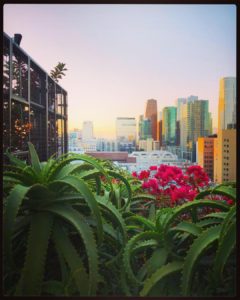
Day 2: Hollywood
On our second day in the City of Stars, let’s move on to Hollywood. First, let’s visit one of the famous Hollywood studios for a behind-the-scenes tour. Contrary to what you might expect, Universal Studios and Warner Bros Studios are not located in Hollywood, but in the nearby Universal (or Studio) City and Burbank respectively. Paramount Studios, on the other hand, are located on Melrose Avenue, and are the ones closer to the Hollywood Boulevard. An avid film fan, I visited the Warner Bros Studios, where some of my favorite TV shows (ER, Friends, and the Ellen DeGeneres Show) were filmed. The studio tour lasted for about two and a half hours, and included a visit to one of the many sound stages and to the museum.
Afterwards, head to Hollywood Boulevard, which – I can reassure you – is in actual Hollywood. Follow the ‘Hollywood Walk of Fame’ with over 2,600 stars paying tribute to some of the biggest names in the entertainment industry. In the evening, make your way to the Griffith Observatory, from which you can admire the city skyline, as well as the famous Hollywood sign (which can also be seen from many other places in LA). To get to Hollywood from DTLA and then back, take the Red Line (or a taxi).
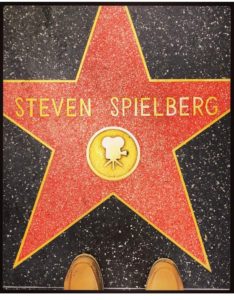
Day 3: Venice Beach & Santa Monica
Having explored Downtown Los Angeles and Hollywood, it’s time to head to the coast. Venice Beach and Santa Monica are the most iconic LA beaches, and can easily be combined, as they lie ‘side by side’. To get there from DTLA, you can take the Expo Line, which runs between Downtown Los Angeles and Santa Monica. The station is not far from the famous Santa Monica pier. You can then walk towards the Venice Beach pier, which is about 3 miles south (about an hour’s walk). On your way there you will join the famous Venice Beach Broadwalk, and you’ll get many opportunities to dip your feet in the ocean and/or enjoy an ice cream. As the sun sets over the Pacific, make sure you have your camera/smartphone ready.
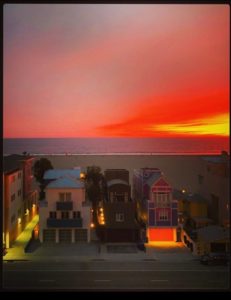
Day 4: LA to Santa Barbara
Having spent a few days in La La Land, it’s now time for the California wine-tasting road-trip to begin…
You should definitely on the Pacific Coast Highway. The drive from Los Angeles International Airport (where you can rent a car) to Santa Barbara, on the Central Coast of California, takes about 2 hours. The earlier you get there the better, as most tasting rooms close in the early evening. Downtown Santa Barbara is dotted with winery outposts; in most places, a flight of five wines usually costs $15 and no advanced booking is required.
Be mindful of the fact that most tasting rooms do not serve any food. You could first have a light lunch at Lilly’s Taqueria, followed by ice-cream at McConnell’s (I had a scoop of the pineapple rum and guava jam, and another one of the double peanut butter chip) and then wine-tasting.
I would recommend the Melville Winery Tasting Room, where I tried their cold-climate Pinot Noir, Chardonnay, and Syrah, all grown in their estate vineyards in Santa Rita Hills in Lompoc. The tasting room is located right next door to McConnell’s, and is one of the few where they also serve cheese platters. Another tasting room I visited was Pali Wine Co.; their vineyards are located both in Santa Barbara County and in Sonoma. This tasting room tends to close later than most, and here you can also find board games to play. Opposite Pali Wine Co, there are two more tasting rooms, of Lafond Winery and Santa Barbara Winery. I did not do any tastings there, only because of the limited time I spent in Santa Barbara. In hindsight, I would’ve stayed there for one more day.
For dinner, there are quite a few options nearby, such as Loquita, Casa Blanca, and Rusty’s Pizza Parlor.
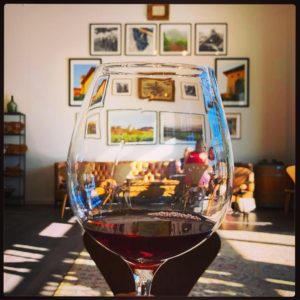
Day 5: Santa Barbara County
Start your day with a cinnamon twirl and coffee at the Santa Barbara Roasting Co. coffeehouse. Once I had a very aromatic cup of chocolate raspberry coffee, the best filter coffee I’ve had in California, I drove to Santa Ynez Valley, home to many wineries, most of which are located 40 minutes to an hour’s drive from Santa Barbara. Driving past the towns of Santa Ynez and Solvang, I arrived at Beckmen Vineyards in Los Olivos. A flight of six wines at Beckmen Vineyards costs $20 and no advanced booking is required.
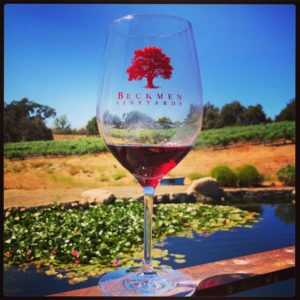
Day 6: Santa Barbara to Big Sur and Carmel-by-the-Sea
Big Sur refers to a section of the Central Coast of California between San Simeon (south border) and Carmel-by-the-Sea (north border). I once read that Big Sur is a state of mind, rather than a specific place, and I couldn’t agree more. The drive is simply spectacular and my words would not do it justice (hopefully my photos will speak a bit louder, but still there’s nothing quite like being there).
The drive from Santa Barbara to Carmel takes about 5 hours (provided there is no traffic). However, given the gorgeous scenery and the number of photo opportunities on the way, I would allow much more time for the journey there.
Approximately half-way between Santa Barbara and Carmel there’s the Hearst Castle, near the small town of San Simeon. Named after the publishing tycoon William Randolph Hearst, the Castle is a hilltop mansion built in the first half of the 20th century. Widely considered a California landmark, it is now open to the public ($25).
After the Hearst Castle, the Big Sur coast officially begins. The narrow two-lane highway can get busy, so to avoid queues I would strongly recommend driving there during the week. Driving southbound offers easier access to the designated vista points, which offer splendid views of the coastline and the ocean, and are also safe places to stop. There are plenty of them, so even if you drive northbound, you’ll be able to safely stop to some of them (there are road signs to inform you when it is safe to do so). An advantage of driving northbound is that you can time your journey so you drive in Big Sur in the evening, so you can watch the sunset from one of the vista points (preferably one closer to Carmel).
An obligatory stop is north of the Bixby Creek Bridge (also known as Bixby Canyon Bridge), an open-spandrel arch bridge built in the early 1930s. It is one of the tallest single-span concrete bridges in the world, as well as one of the most photographed bridges in California and the West Coast of the US. From there, Carmel-by-the-Sea is about 20 minutes away.
In Carmel, I would recommend dinner at the Forge in the Forest, a cozy Californian restaurant with a beautiful outdoor patio.
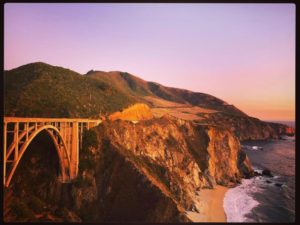
Day 7: Drive to Yosemite National Park
I only stayed in Carmel for a night; if I had more days, I would’ve spent one more day there, and would have also visited the neighboring town of Monterey, where the famous jazz festival takes place every September.
The drive to the Yosemite National Park in the Sierra Nevada mountains is nowhere as scenic as the drive on the Pacific Coast Highway, and takes about 4 hours (to the Yosemite Valley Visitor Center). Again, I would strongly recommend avoiding the weekend. The park entrance fee costs $35 (per vehicle) and is valid for 7 days, during which you can drive in and out of the park.
The Yosemite Valley is a great place for hiking; there are quite a few hiking trails to choose from, so the more time you have the better. These trails can take you from the Visitor Center in the Yosemite Village (be mindful this is not a real village) to natural and historic landmarks, such as the renowned Yosemite Falls, the Mirror Lake, and the historic Ahwahnee Hotel. Unfortunately, I did not have enough time to have a drink at the Ahwahnee or visit the Mirror Lake.
Be mindful, however, that your accommodation may not be very close, so make sure you leave before the sun sets. The drive through the forest will not only be easier, if there’s still daylight, but also much more enjoyable.
The Glacier Point is a great place to watch the sunset from; however, I did not have time to make it there in time for the sunset, so I visited the following morning instead. In case there’s a queue, a good alternative would be stopping at Washburn, which is less than a mile before the Glacier Point and offers equally pristine views of the valley, the mountains, and the famous Half Dome; this can save you a lot of time and is worth a compromise.
For dinner, I would recommend the Narrow Gauge Inn’s Dining Hall & Buffalo Bar.
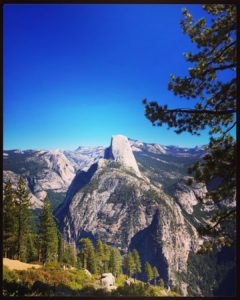
Day 8: Drive to Napa Valley
Spend the morning driving around the Yosemite National Park, before you continue to the Napa Valley. The drive from the Yosemite Valley Visitor Center to the City of Napa takes about 4 hours.
Napa County is home to many Michelin-starred restaurants; most of them are located in Downtown Napa and Yountville (10 and 9 respectively).
In Downtown Napa, I would recommend the Bounty Hunter Wine Bar & Smokin’ BBQ, not a Michelin-starred restaurant, but nonetheless renowned for the beer-can chicken, a whole chicken roasted over a can of Tecate.
In Yountville, there’s the French Laundry, which a few years ago was voted the best restaurant in the world. Despite its name, it serves Californian cuisine. The French Laundry’s neighbors Ad Hoc(also Californian cuisine), Bouchon Bistro (French cuisine), and Bouchon Bakery (all located a few doors down on Washington Street) are also owned by the world-renowned chef Thomas Keller, and have all been awarded with the much-sought Michelin stars.
Other Michelin-starred restaurants in Napa Valley are Mustard’s Grill, a highly-praised restaurant serving fine American cuisine for over 30 years now, and Rutherford Grill, further up north past Oakville and towards Rutherford.
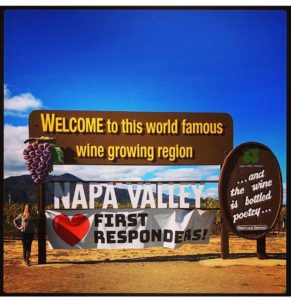
Day 9: Napa Valley
Start your day with coffee and a hearty breakfast. In Downtown Napa, you can choose between the Napa Valley Coffee Roasting Co., the Sweetie Pies Bakery, and the Alexis Baking Company.
The Napa Valley winery map is like the wine menu in a wine bar. With more than 400 vineyards, most of which are family-owned and operated, the question arises: which ones to visit?
The easy answer is to book a wine tour and let the tour organizers decide (and most importantly take you there, so you don’t have to worry about driving). This is a great option especially if time is limited, and is the one I opted for. I chose the Napa Valley Wine Trolley Classic Tour, which took me to a 6-hour journey to the lower half of the Napa Valley. We met in downtown Napa and then visited four wineries (Pestoni Family, Cosentino, Silenus and Andretti) near the towns of Yountville, Oakville, and Rutherford. These visits included the so-important wine tastings, vineyard and winery tours, and there was also food served. Overall, it was a great experience which allowed me not only to taste different wines in the very locations where they are produced, but also to meet like-minded visitors from different parts of America and the world.
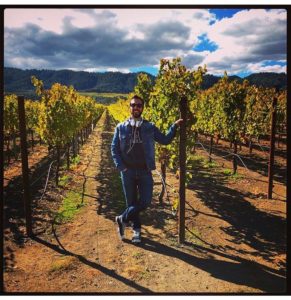
After the 6-hour tour, continue to the Oxbow Public Market in Downtown Napa. This is a large indoor market with many stalls, selling a variety of products; there is also a seating area where you can dine. Or, alternatively, you can follow my example and dine at Gott’s Roadside; one of the seven branches is located right next to the Oxbow Market. Afterwards, head to the Three Twins for locally-produced organic ice-cream. Oxbow Market is home to one of their three locations; the other two can be found in San Rafael and Larkspur.
Afterwards, you could continue to San Francisco, or alternatively head there the following morning. To get there, take the Bus No 29 to El Cerrito Del Norte, and from there the BART train to Downtown San Fran.
Day 10: San Francisco Historic Center
Kick off your day with breakfast and coffee. I had buttermilk pancakes at Honey Honey Café & Crepery on Post Street, and then walked up the hill towards Chinatown. Dragon’s Gate (at the corner of Bush Street and Grand Avenue) is the landmark entrance into this iconic neighborhood. Continue further uphill to the historic Caffe Trieste on Vallejo Street. This is where Francis Ford Coppola drafted his script for The Godfather. Not far from there is the small but worth-visiting Jack Kerouac Alley, the famous bookstore City Lights Booksellers & Publishers, and the landmark bakery Golden Gate Fortune Cookie Factory.
Walk downhill towards the Financial District and from there to SoMa (South of Market Street). Make your way to the San Francisco Museum of Modern Art (SF MoMA) on 3rd Street (closed on Wednesdays). I spent several hours fully immersed in art by Picasso, Matisse, Pollock, Mondrian, Warhol and Lichtenstein. On the third floor of the museum, there’s a recently opened Sightglass coffee bar.
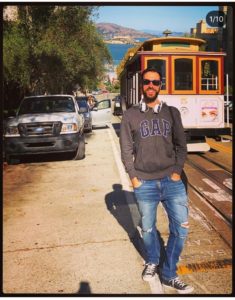
Day 11: To the Golden Gate Bridge
Start your day with coffee and breakfast (pancakes, again) at Dottie’s True Blue Café (on 6th Street). I would strongly recommend getting there early (i.e. 7.30) to beat the crowds and avoid queuing. Then, go to Powell and Market, and take the Powell-Hyde line. Boarding a cable car is not as easy as you might assume. First, there are only three lines operating today (Powell-Hyde, Powell-Mason, and California Street). Second, most of the passengers are tourists, who often queue for an hour or two (another reason to get up early). The single ride costs $7. The cable car will take you to the Hyde and Beach terminal; on the way there, you will be treated to some spectacular views of the Golden Gate Bridge and the Alcatraz.
Once you’ve ridden the cable car, head to the Original Ghirardelli Ice Cream & Chocolate Shop at Ghirardelli Square. Continue to the Warming Hut Bookstore & Café, where you can enjoy close-up views of both the Golden Gate Bridge and the Alcatraz. It is about an hour’s walk from Ghirardelli Square (so you can burn off the pancakes and the ice cream). On your way there, make a small detour to admire the very fine Palace of Fine Arts.
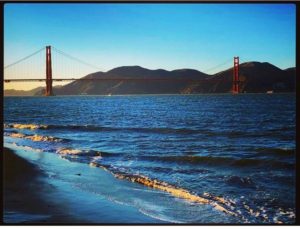
Day 12: From the Mission District to Castro and to the Golden Gate Park
On your third day in San Francisco, you can explore some of the somewhat less central neighborhoods. Take the BART to the 24th St Mission. I personally did not find the Mission District particularly exciting (but perhaps I visited at the wrong time of the day); after a brief walk among the taquerias and the hipster hangouts, I walked up the 24th Street to Noe Valley, a beautiful family-friendly neighborhood. I then continued on Castro Street to the Castro District, synonymous with gay culture. Walk past the Castro Theater, another landmark building, and continue on Divisadero Street making your way to the iconic Alamo Square Park.
On your way there, have a coffee at the Mill, one of my favorite coffee shops in San Francisco; it is located on Divisadero Street, about 20-minutes walk from the Castro Theater. Afterward, have a stroll at the Buena Vista Park and wander through the hippie neighborhood of Haight-Ashbury. Then, walk through the rectangular Golden Gate Park.
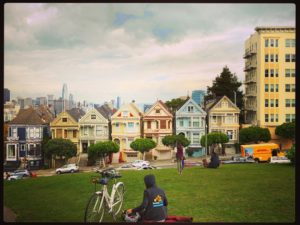
When to visit California
California is renowned for its Mediterranean climate and pleasant weather, which has helped the Golden State become the state with the largest wine production in the US. In general, Los Angeles tends to be warmer than San Francisco.
I would recommend planning your visit to coincide with one of the many music or film festivals taking place in California. Most of these festivals take place in the fall, when the weather is very pleasant:
Kaaboo
Kaaboo is an annually held festival, established in 2015. This year, it took place in Del Mar, a beach city near San Diego, California. Getting there was easy; from LA, I took the train to San Diego and got off at Solana Beach (the journey took about two hours) where I stayed for the duration of the festival. Next year, however, it is going to take place in Downtown San Diego (from 18th to 20th September 2020).
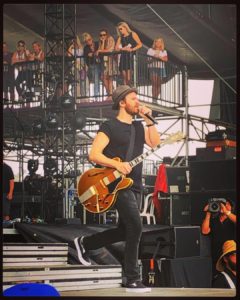
Monterey Jazz Festival & other jazz festivals
The Monterey Jazz Festival is a renowned jazz music festival taking place in Monterey, a small city near Carmel and Big Sur and south of San Francisco. It is scheduled for 25th to 27th September 2020.
But, the Monterey Jazz Festival is not the only one of its kind in California.
The San Jose Jazz Summer Fest takes place in San Jose, not far from San Francisco; it is scheduled for 7th to 9th August 2020.
There’s also the SLO Jazz Festival, which takes place in San Luis Obispo, in Central California, halfway between LA and San Francisco; it is scheduled for 18th to 20th September 2020.
In October, there’s the JazzTrax Festival taking place in Santa Catalina, a small island southwest of LA. It is schedule for 8th to 18th October 2020.
Last but not least, there’s the San Diego Jazz Fest, due from 27th November to 1st December 2019.
Coachella Valley Music and Arts Festival
Yet, the most famous music festival in California (and possibly in the US) is the Coachella Valley Music and Arts Festival, or simply Coachella. Featuring some of the biggest names in music, it takes place over two consecutive 3-day weekends in April. Next year, it is due from 10th to 19th April 2020. Like Kaaboo, Coachella also takes place in Southern California, but in the Colorado Desert. Here the temperature rises to much higher levels than in Del Mar. The host city, Indio, is only a few miles east of the better-known city of Palm Springs. Getting there by public transport is not straightforward. You can either fly to Palm Springs, or simply drive there.
Stagecoach
Stagecoach, a 3-day country music festival, also takes place in Indio, and also in April. In 2020 it will be headlined by Thomas Rhett, Carrie Underwood, and Eric Church; the line-up also features Brett Young, Dan + Shay, and Bryan Adams. Stagecoach is scheduled for 24th to 26th April 2020.
Napa Valley Film Festival (NVFF)
The Napa Valley Film Festival takes place every November. This year, the schedule featured over 50 films (including short, feature and documentary films). Next year, it is scheduled for 11th to 15th November 2020. Considering the pivotal role that wine and gastronomy play in Napa Valley, it comes as no surprise that the menu (sorry, schedule) also features a delicious selection of mouth-watering ‘culinary films’. This cinematic journey into the world of food and wine is further enhanced with special events including culinary demonstrations, masterclasses, and wine intermissions. So, forget popcorn, nachos and Coca Cola, and discover the region’s rich culinary scene and world-famous wines between film screenings.
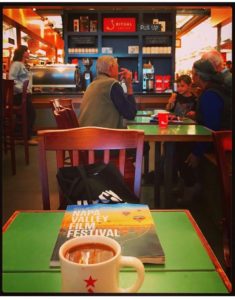
Santa Barbara Surf Film Festival
Also in November, there’s the Santa Barbara Surf Film Festival, a two-day annual event which was inaugurated this year. The 2020 dates have not been announced yet.
Getting there and around California
In general, public transport in California is very rudimentary compared to Europe. LA and SF are not an exception to that rule.
Unfortunately, there isn’t a Metro station at the Los Angeles International Airport (LAX). There is a bus service connecting LAX with DTLA; however, the buses are not as frequent as we’re used in Europe. The best way (but not the cheapest, if you’re traveling solo) may therefore be to take a taxi; Uber and Lyft are both very popular options.
In LA and San Fran, I personally used Uber Pool quite a lot; this saved me considerable time and was also relatively inexpensive, especially when I shared a ride with my travel companion. I am ever so grateful to the ubiquitous Starbucks for their free WiFi that made this possible (since I don’t have an American mobile, or cell phone as they call it over there).
From LA, rent a car for your road-trip all the way to the Napa Valley.
To get from there to San Francisco, take the Bus No 29 to El Cerrito Del Norte, and from there the BART train to Downtown San Fran.
From there, you can get the BART train to the San Fransisco International Airport (SFO).
Accommodation in California
Los Angeles
If you visit Los Angeles for the first time, I would recommend staying in Downtown LA. This is especially convenient if you plan to use public transport, or take the train to another city, since the main rail station (Union Station) is on the edge of DTLA. During my visits to LA, I have stayed in the following hotels:
Hotel Figueroa
This is a historic boutique hotel on Figueroa Street; it is located right between the Grammy Museum and the Staples Center (on the one hand) and the Original Pantry Café (on the other). Philz Coffee is not far from there either. The hotel has a rather small outdoors coffin—shaped pool, from which you can admire part of the city’s skyline, and the impressive Bella Gomez mural on the back wall of the hotel. Breakfast is free for all guests and is served in the main foyer/bar area (cocktails are not free).
Millennium Biltmore Hotel
This is another historic hotel located on Grand Avenue (yay) and overlooking the Pershing Square (nay). It is a few minutes’ walk from the Museum of Contemporary Art (MOCA), the Grand Central Market and some of my favorite cafes (G&B, Blue Bottle Coffee). It has a beautiful indoor swimming pool and a cocktail bar.
The Mayfair Hotel
This is another historic boutique hotel, located on the 7th Street. When I stayed there, it was being renovated; nonetheless, I was impressed with the contemporary artworks decorating the hotel.
ACE Hotel
There’s also the hip ACE Hotel on Broadway, a couple of minutes’ walk from Verve Coffee. I have not stayed there, but I’ve been to the rooftop bar for cocktails and panoramic views of the city’s skyline.
Santa Barbara
I stayed at the Hyatt Centric. Located on the seafront, it is within walking distance from Downtown Santa Barbara (a pleasant walk along the Pacific coast).
Carmel-by-the-Sea
I stayed at the Vendange Carmel Inn & Suites, a wine-themed inn within walking distance from the Forge in the Forest, where I had dinner. Breakfast was included in the price, which explains why I did not further explore Carmel.
Yosemite National Park
In the Yosemite National Park, I stayed at the Narrow Gauge Inn, in Fish Camp. This mountain resort is about an hour’s drive from the Yosemite Valley Visitor Center. Breakfast is included in the price.
Napa Valley
I would recommend staying in the City of Napa.
San Francisco
If you visit San Francisco for the first time, I would recommend staying in Downtown. During my visits to San Fran, I have stayed in Serrano Hotel Union Square (on Taylor Street) and in Hotel Union Square (on Powell Street). They’re both within walking distance from Powell St Station; they’re also close to Powell and Market (where you can take the cable car), to the shops, and to most coffeehouses I have recommended. In the morning, they serve free coffee in the lobby. Although both hotels are located in the notorious Tenderloin area, frequented by homeless people, I felt safe even when walking on my own at night.
Further reading on California
To better prepare for my trip to California, I used the Lonely Planet California Travel Guide.
For more tips, check out my posts about Los Angeles, Santa Barbara, Big Sur, Carmel-by-the-Sea, the Yosemite National Park, Napa Valley, and San Francisco.
Also, check out my post ‘A musical journey to California’.
To follow my travels around the world, simply subscribe to the Traveling Psychiatrist (subscription button on the left-hand side).
My e-book ‘Greek Islands: Top tips by an (almost) local’ is available for FREE for every new subscription (for a LIMITED TIME ONLY).
Alex
(the Traveling Psychiatrist)